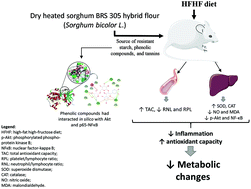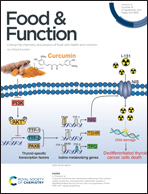Dry heated sorghum BRS 305 hybrid flour as a source of resistant starch and tannins improves inflammation and oxidative stress in Wistar rats fed with a high-fat high-fructose diet†
Abstract
This study aimed to evaluate the effect of dry heated sorghum BRS 305 hybrid flour, as a rich source of resistant starch and tannins, on inflammation and oxidative stress in animals fed with a high-fat high-fructose diet. Phase 1 (8 weeks): male Wistar rats were divided into a group fed with an AIN-93 M diet (n = 10) and a group fed with a high-fat (35%) high-fructose (20%) (HFHF) diet (n = 20). Phase 2 (intervention 10 weeks): the control group was continued with the AIN-93 M diet (n = 10) and the HFHF group was divided into HFHF (n = 10) and sorghum flour (n = 10) groups. Sorghum flour decreased the NO, Akt, p65-NFκB, TLR4, and lipid peroxidation in the liver. Furthermore, sorghum flour improved SOD and CAT activities and the total antioxidant capacity of plasma. The phenolic compounds found in sorghum flour interacted in silico with AKT and p65-NFκB, mainly quercetin-3-rutinoside that showed the highest interaction with AKT (EFE −8.0) and procyanidins B1 and B2 that showed the highest interaction with p65-NFκB (EFE −8.9). The consumption of BRS 305 sorghum with a high tannin and resistant starch content improved inflammation and oxidative stress by inhibition of p65-NFκB activation in rats fed a high-fat high-fructose diet.



 Please wait while we load your content...
Please wait while we load your content...